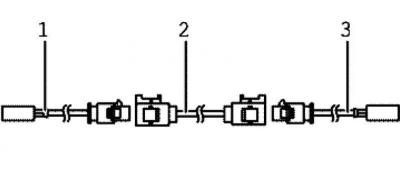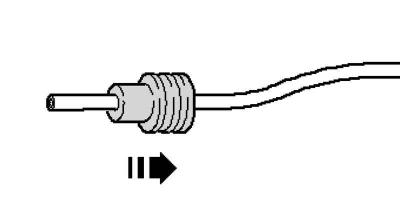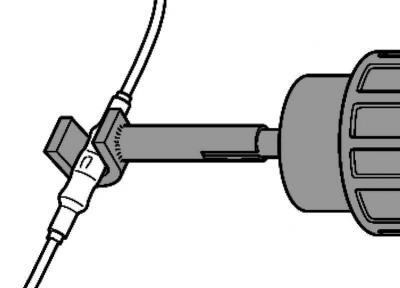The color coding of the CAN bus wires can be found in the following table
CAN-High bus wire, drive orange/black;
CAN-High bus line, comfort orange/green;
CAN-High bus wire, Infotainment orange/violet;
CAN Low wire (All) orange/brown.
Repair of CAN bus wires can be carried out using both a repair wire of a suitable cross section and twisted wires «green yellow» or «White yellow» in accordance with the spare parts catalog.
When repairing, both bus wires must have the same length. When twisting wires 1 and 2, the length of the coil must be A=20 mm.
In this case, a piece of wire must not form, for example, in the area of welded contacts longer than B = 50 mm without twisting the wires.
Wrap the repaired section with yellow duct tape to indicate that a repair has been made in this area.
Replacing Antenna Wires
A new repair concept has been developed for the repair of antenna wires. As spare parts, instead of complete antenna cables, connecting cables of various lengths are now available, as well as a variety of adapter cables.
General description
Antenna wires cannot be repaired. If repairs are necessary, they must be replaced with connecting wires and adapter cables available as original spare parts.
These original spare parts are suitable for replacing all antenna wires of any size.
The connector housings for the antenna cables are only available as a spare part in one color but can be used to replace antenna connectors of any color.
Individual antenna plugs cannot be replaced in the event of a repair.
These wires can be used in all VW models with antenna wires of any size.
All connecting wires and matching cables are suitable for any received and transmitted signals.
This repair concept can also be used for testing and accessories.
Antenna wire installation overview
Example: the antenna wire from the radio to the antenna is damaged. The following wires are required for repair:
- 1 - adapter cable, for connection to the radio. Length about 30 cm.
- 2 - connecting wire, supplied in various lengths.
- 3 - adapter cable, for connection to the antenna. Length about 30 cm.
Installing a new antenna wire
Disconnect the plugs of the damaged antenna wire from the devices.
Note: Please note that depending on the vehicle equipment, the total length of the aerial cable can be divided into sections due to aerial selection control units, radio control units or aerial amplifiers. In each case, only the damaged section needs to be replaced.
Determine the location of the damaged antenna wire in the vehicle and measure the total length of the damaged antenna wire.

Pic. 7.127. Wires needed to repair the antenna wire
The total length of the antenna cable consists of the length of the necessary adapter cables 1 and 3 and the length of the connection cable 2 (pic. 7.127).
Subtract 60 cm from the measured total length of the antenna wire to determine the length of the required connection wire 2.
Obtain the required adapter cables 13 as well as connecting cables 2 of the correct length according to the spare parts catalogue.
Cut off the plugs of the damaged antenna wire.
The rest of the damaged antenna wire remains in the vehicle.
Connect adapter cables 1 and 3 to the devices in the vehicle.
Lay and secure connecting wire 2 directly next to «serial» wire.
Note: Antenna wires must not be kinked or severely bent. The bending radius must be at least 50 mm.
Connect the connecting wire with adapter cables.
Check.
Repair of wires up to 0.35 mm2
When repairing wires with a cross section of up to 0.35 mm2 it is absolutely necessary to press new lugs with a crimp tool for JPT contacts, or a crimp tool (headless) VAS 1978/ 12 with an installed replaceable head for contacts JPT – VAS 1978/ 91. Due to the small values of the current in these wires, in the micro and milli-band, incorrectly pressed contacts lead to transient resistances and cause failures or failure of any system. Most often such contacts are found in the following devices:
- Lambda probe;
- speed sensor;
- mass air flow meter.
By using crimping tool for JPT contacts or crimping tool (headless) with a replacement head for JPT contacts, a correct connection between the crimp contact, the wire and the wire gland is ensured (Seal). Use the tool only for its intended purpose.
Note: The repair wires have standard or gold plated ferrules. When repairing, always use the same tip that was originally used.
Crimping a new ferrule with a wire seal
Insert replacement head for JPT contacts into crimping pliers (handle base).

Pic. 7.128. Installing the seal
Push the wire seal onto the repair wire (pic. 7.128).
Note: The smaller diameter of the seal must be on the side of the tip.

Pic. 7.129. Inserting the wire into the crimping pliers
Open the crimping pliers and insert the end of the repair wire into the stripping hole (pic. 7.129).
Squeeze the tongs completely.
Open the pliers again and remove the stripped wire.
Slide the wire seal toward the stripped end so that it ends flush with the wire insulation.
Insert a new crimping lug into the jaw of the crimping tool.

Pic. 7.130. Inserting the wire into the crimp terminal
Insert the stripped end of the wire with the aligned seal into the crimp lug until the end is against the mark «Wire-Stop» (pic. 7.130).
Crimp the ferrule, wire and seal by fully squeezing the crimping tool.
Open the pliers again and remove the finished tip.

Pic. 7.131. An example of a correct wire crimp
Correctly performed crimping is distinguished by a clean crimp of the wire and seal in the lug, and on its reverse side there is a embossing, which indicates that the crimping was performed professionally and with the proper tool (pic. 7.131).
Wire break in one place
Repair point with one crimp sleeve
Release the wire that needs to be repaired (about 20 cm on both sides of the repair site).
If necessary, remove the wiring harness wrap with a jackknife.
Cut out the damaged piece of wire with insulation stripping pliers.
Note: If both remaining ends of the wire, due to cutting out the damaged length, are too short to repair with a single ferrule, then use a length of wire of the appropriate length by installing two ferrules.

Pic. 7.132. Wire stripping
Strip 6-7 mm of insulation from the ends of the wire using a wire stripper (pic. 7.132).

Pic. 7.133. Crimping of a crimp sleeve
Push the crimp sleeve onto both stripped ends of the wire and crimp it with crimping pliers (pic. 7.133).
Note: Be sure to use the correct ferrule for the used ferrule.
The wire insulation must not be crimped.
After crimping, the crimp sleeve must be seated to prevent moisture from entering it.
Install the nozzle on an industrial hair dryer, 220 V / 50 Hz.

Pic. 7.134. Heating up the crimp sleeve
Heat the crimp sleeve with a hair dryer in a longitudinal direction from the middle to the edges until it shrinks completely and glue comes out at the ends (pic. 7.134).
Attention: When shrinking crimp connections, make sure that the hot nozzle of the hot air gun does not damage other wires, plastic parts or insulation.
Attention: Please follow the instruction manual for the hair dryer
Note: If several wires need to be repaired, a certain distance between the crimp sleeves must be observed. so that the wire harness does not turn out to be too thick in the girth after repair, install the crimp sleeves with some offset relative to each other.
Note: If the originally repaired area was wrapped with electrical tape, then after repair it should be wrapped with yellow electrical tape.
Note: The repaired wiring harness should then be secured with a wire tie, if necessary, to avoid extraneous sounds when driving.

Visitor comments